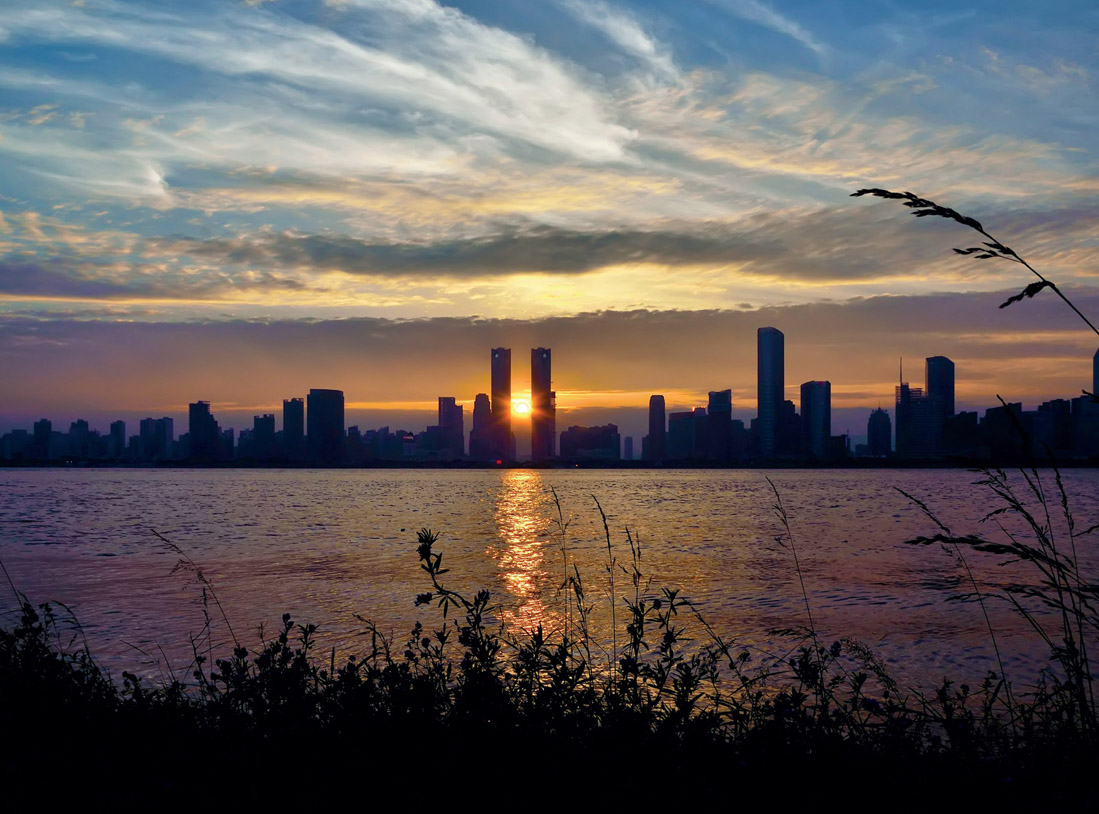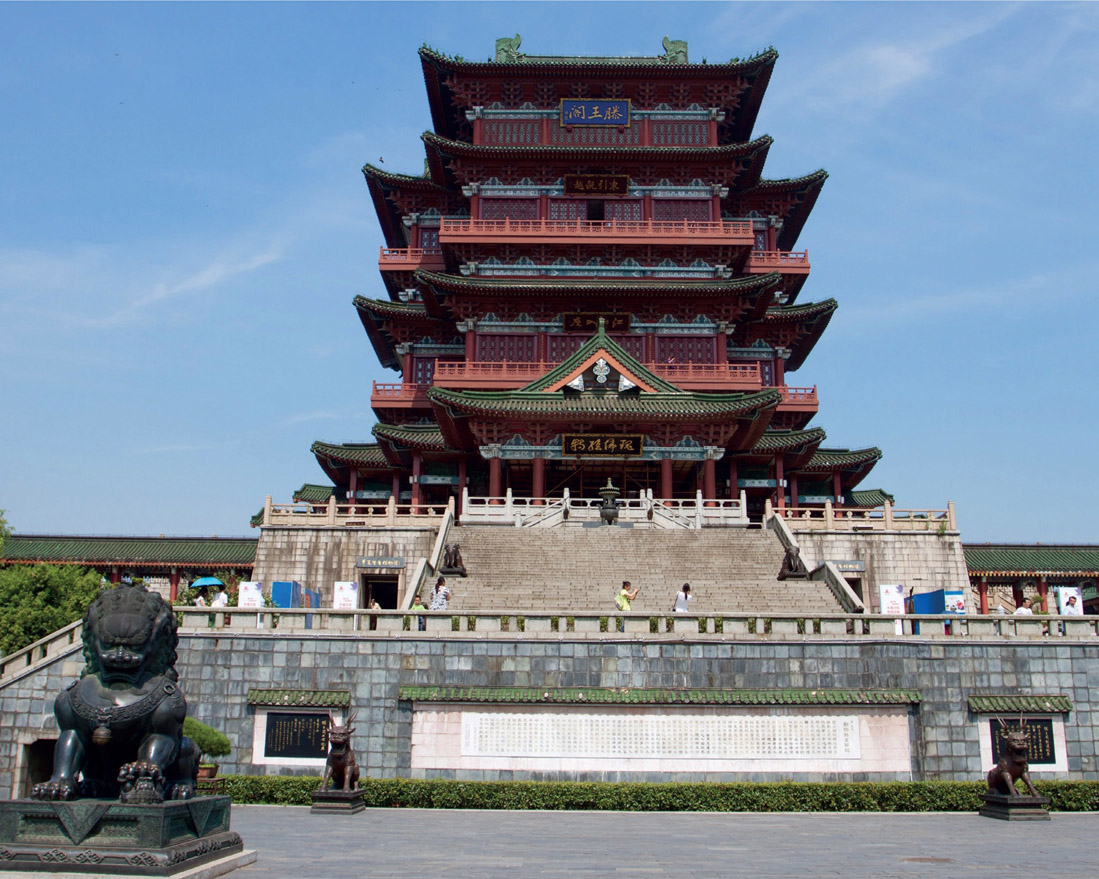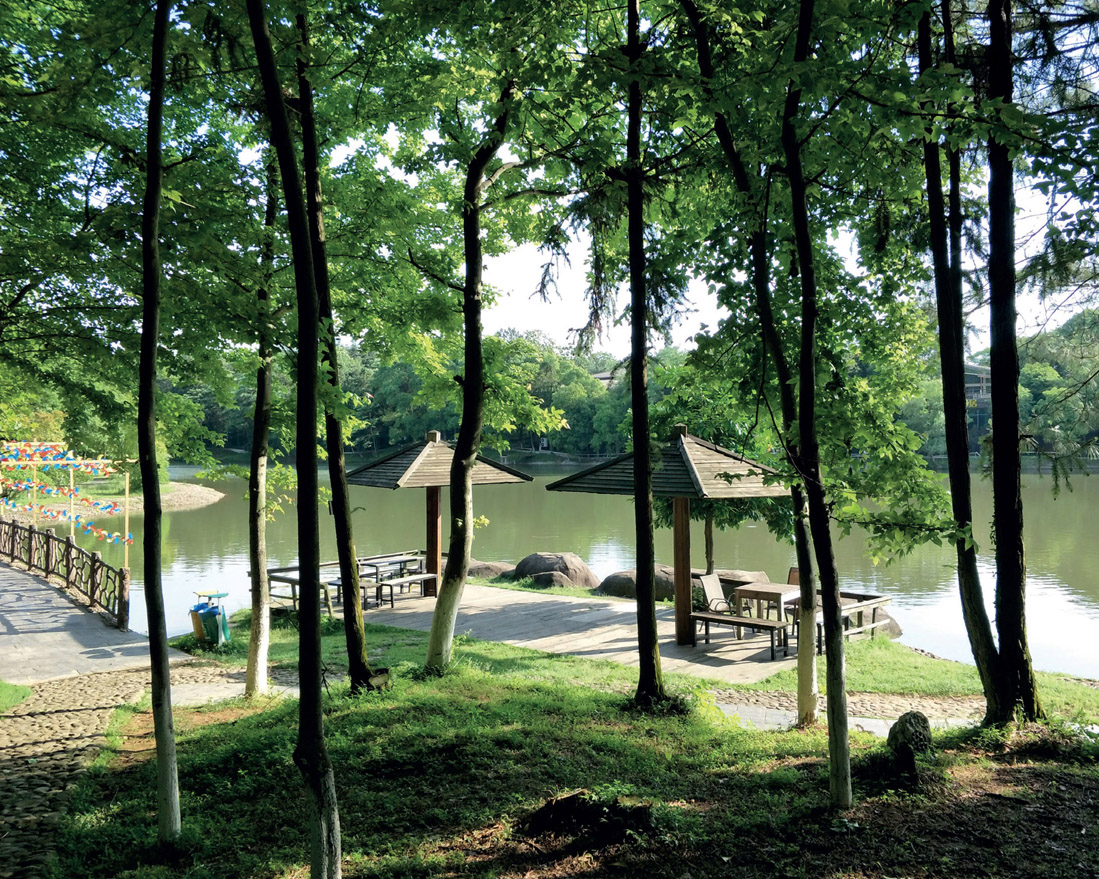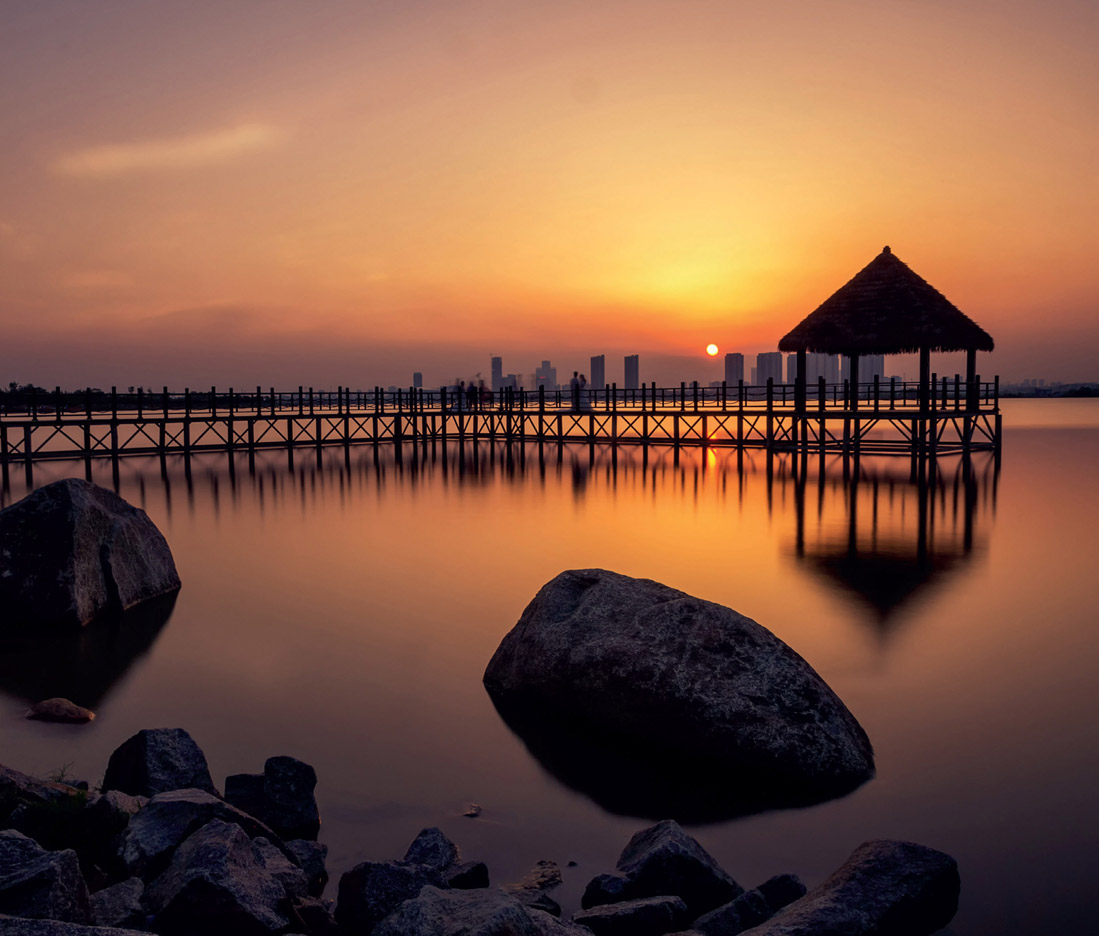8
Nanchang: Towards a Low-Carbon City
A dominant feature of China’s urban development and an ongoing preoccupation for many outside observers is the high use of carbon-based energy sources. However, China is currently emphasising and developing much more efficient and low-carbon energy sources.
To be significant this must not only apply to high-profile cities such as Shanghai but also must become part of mainstream development. Nanchang, although much less well-known, is more representative of this stage of China’s urban priorities both in terms of energy and the incorporation of the natural environment.
Nanchang has a compelling strategy for industrial transformation in the context of its distinctive topography and natural setting. It demonstrates that China’s urban concerns are not limited to the most famous and fashionable centres.

Figure 8.1: Nanchang Bayi Bridge
An Overview of Nanchang
Nanchang is the capital city of Jiangxi Province in southeastern China, located in the mid-north of the province, downstream of the Gan and Fu Rivers. It is on the southwest shore of the biggest freshwater lake in China, Poyang Lake. In the northwest the city is hilly while to the southeast there are many lakes and a dense water network. The Nanchang Uprising of 1 August 1927 is recognised by the Communist Party as ‘firing the first gunshot against Nationalists’. The city has been known as ‘the City of Heroes’, ‘the birthplace of the People’s Liberation Army’ since 1949.
At the end of 2014, the city’s resident population was 5,240,200, and the total GDP of Nanchang was CNY366.796 billion. From 2012 to 2014, Nanchang took, respectively, the seventy-second, one hundred and fifteenth, and fifty-seventh position in the ranking list of China’s Urban Transformation and Upgrading Capability. The city covers an area of 7,402 km2, 617 km2 of which is urban area and 220 km2 of which is built-up or urbanised area. The following counties, districts, and areas are under the jurisdiction of Nanchang Municipal Administration: Nanchang County (南昌县), Jinxian County (进贤县), Anyi County (安义县), Donghu District (东湖区), Xihu District (西湖区), Qingyunpu District (青云谱区), Qingshanhu District (青云谱区), Wanli District (湾里区), and Xinjian District (新建区), as well as Nanchang Economic and Technological Development Zone (南昌经济技术开发区), Nanchang High and New Technology Industry Development Zone (南昌高新 技术开发区), and Honggutan New District (红谷滩 新区). In 2016, Jiangxi Province officially released the Grand Nanchang Metropolitan Area Planning, whose space range includes the whole region of Nanchang and part of Fuzhou, Yichun, and Shangrao. According to the planning, Nanchang Metropolitan Area will include 23,000 km2 with a permanent population of 14 million by 2030.
The Basis and Challenges of Nanchang’s Transition to a Low-carbon City
In 2009, the First World Low Carbon and Ecological Economic Conference took place in Nanchang. The city’s efforts to construct a low-carbon city were facilitated through extensive international cooperation with technical support from the United States, the United Kingdom, and Austria. In the same year, the National Development and Reform Commission (NDRC) selected Nanchang as one of the first pilot low-carbon cities.
The city has favourable conditions for constructing a low-carbon city due to the natural environment and its climate. Nanchang is located in a subtropical evergreen broad-leaved forest zone, with four distinct seasons and a mild climate. This natural environment greatly facilitates the forming and protection of a diversified ecology. Moreover, Nanchang lies near Poyang Lake, which provides abundant food for migrant birds to live and breed in the wetlands. This ‘urban migrant birds’ scenario is the environmental basis for the city’s development.

Figure 8.2: Xiang Lake Wetland Park, Nanchang City

Figure 8.3: Ganjiang Riverside of Nanchang City
Rapid Economic Development
This is defined as ‘economic improvement, rapid change and everyone striving for prosperity’.
A Foundation of Environmental Protection: ‘Forest and Garden Nanchang’
In recent years, Nanchang has promoted a circular economy to improve resource-dependent industries. During the Eleventh Five-Year Plan, the unit power consumption fell by 20 per cent, and the discharging of major pollutants dropped, meeting the Plan’s target. The urban sewage centralised processing rate reached 92 per cent and harmless treatment rate of household garbage attained 100 per cent.
Now energy-saving design and energy auditing has been applied comprehensively in new building construction projects together with the application of reusable energy.

Figure 8.4: Pavilion of Prince Teng in Nanchang City
The Challenges for Nanchang:
Unbalanced Industrial Structure of Nanchang
The industrial layout of Nanchang concentrates on low-end manufacturing industry with low resource utilisation rate. The proportion of high-quality products, high-tech products, and high added-value products is still low. Most enterprises are small and medium. It lags behind coastal areas, where there are many large enterprises of high efficiency and advanced management. Nanchang is also facing new problems of industry transfer. Many enterprises with potential environmental issues are keen to relocate to Nanchang from coastal areas, and this will bring further problems.
Nanchang’s improvement in these areas is still insufficient to keep up with economic development and population growth. It is short of investment in transportation, water supply, drainage systems, and hazardous waste treatment facilities. The tension between rapid urban development and underdeveloped infrastructure has become increasingly acute.

Figure 8.5: Garden City, Nanchang
Improvement of the Supervision System for Sustainable Development
Proposed real-time environment monitoring networks and an environment safety pre-alarm system have not yet been installed. Natural ecological protection and administration systems also need to be strengthened.
The rapid development of the economy brings new pressures to the ecological environment system. Some towns have set up Industrial Development Zones without comprehensive investigation, which results in the emergence of high energy-consuming and high pollution enterprises.
Strategy and Implementation in Constructing a Low-carbon City
The core of the strategic implementation plan is the Poyang Lake Ecological Economic Zone – constructing ‘one base, three centres and four Nanchangs’.1 The focus is a harmony between humans and nature, with quality of life as the starting point. In practical terms, there has to be an alignment between industrial structure, the resource utilisation rate and the environment of mountains, rivers, and lakes.

Figure 8.6: Photovoltaic Cells, Nanchang
Constructing a Low-carbon Industrial System
Nanchang puts industrial transition and upgrade as a strategic priority. The development of four low-carbon industries is at the forefront: solar photovoltaic, green illumination, service outsourcing, and cultural tourism.
The city seeks to develop six new low-carbon industries: new-energy cars, modern logistics, aviation manufacturing, new-energy equipment, biomedicine, and new materials.
It also strives to reduce the carbon dioxide emissions from four high-carbon industries: ferrous metal smelting and rolling/processing, chemical materials and chemical manufacturing, non-metallic mineral production, and paper production.
Nanchang also actively promotes low-carbon agriculture through the ‘Million Mu of Fine Land’ project to increase agricultural land output and comprehensive efficiency.
In the development of the service industry, Nanchang focuses on the modern finance service industry, modern tourism, logistics, trade and commerce, the trade service industry, and the information service industry.
Constructing a Low-carbon Energy System
Nanchang has strengthened the economy by improving the resource utilisation rate and reducing energy consumption and waste emissions. At the same time, the city is altering the structure of energy supply by halting the construction of thermal power plants, limiting the expansion of existing thermal power plants, and improving electricity-generating efficiency. Therefore, by changing both the power consumption and supply modes, Nanchang has tried to match low-carbon power with low-carbon industry.
Improving Low-carbon Space Layout
Urban transition means changing the urban space layout, including replanning the existing urban space structure, and designing new urban space. Nanchang pinpoints and utilises the natural carbon-bearing capacity. It connects wetlands, lakes, forest, and parks, and seeks to achieve an urban ecological carbon-bearing network.
The low-carbon city becomes visible through solar roofs, solar street lights, three-dimensional gardens, electrical bus stations, green buildings, and waste sorting.
Nanchang has a Transit-oriented Development (TOD) strategy to build a new transportation network that interconnects both urban and rural areas. With subway transportation as the centre, it strengthens the seamless connection between the slow-transportation system and the subway. Nanchang strictly executes the emission standards for motor vehicles and encourages the use of new-energy vehicles.
The planning and layout of Nanchang’s urban space accepts the template of the city’s geography to shape its environmental priorities.
Constructing Low-carbon Buildings
With the emphasis on saving energy, water, and land; materials; and reusing energy, Nanchang strictly implements such standards in new buildings. Nanchang also initiates the renovation of existing high-energy consumption buildings. To renovate existing buildings, Nanchang has set up a real-time monitoring system of energy consumption for government buildings and large public buildings. It implements an energy audit and quota management mechanisms for these buildings.
Constructing Carbon Fixing and Reducing Carriers
Based on its own natural features, Nanchang constructs a ‘mountain–river–city–lake’ basic ecological framework. Nanchang is actively constructing carbon fixing and reducing carriers besides carbon emissions. The city is trying to restore ecological resources in Water Resource Reservation Zones and forests. It develops protection for and low-carbon tourism in wetland and forest resources. The Nanchang Low-carbon Development Plan (2008–20) was implemented to set up developing goals and timetables (Table 8.1).

Figure 8.7: Yao Lake Wetland Park, Nanchang
Table 8.1: Goals of Ecological City Construction in Nanchang


